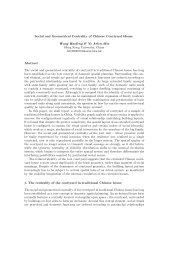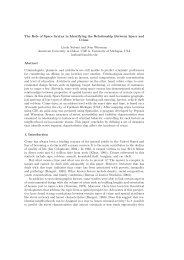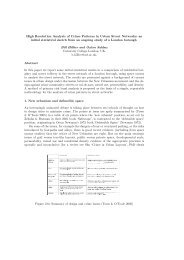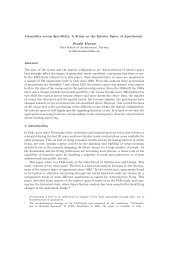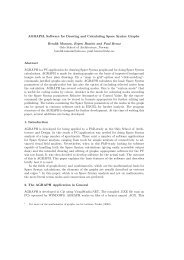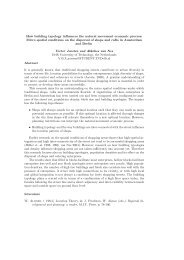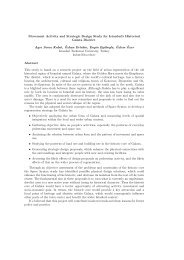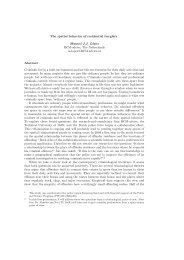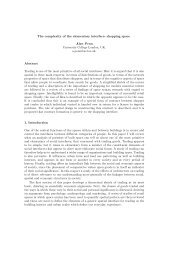Seen in a different light. Icons in Byzantine museums and churches ...
Seen in a different light. Icons in Byzantine museums and churches ...
Seen in a different light. Icons in Byzantine museums and churches ...
You also want an ePaper? Increase the reach of your titles
YUMPU automatically turns print PDFs into web optimized ePapers that Google loves.
256 G. Stavroulaki <strong>and</strong> J. Peponis<br />
Figure 107: Selected view<strong>in</strong>g positions (black, grey <strong>and</strong> white st<strong>and</strong> for dist<strong>in</strong>ct, <strong>in</strong>dist<strong>in</strong>ct<br />
<strong>and</strong> elusive visibility;) a. icon 1, b. icon 2<br />
these “icon-capture” or “to-icon” polygons. In order to draw them we have followed a set of<br />
conventions. First, we have taken the icon-exposure polygons <strong>and</strong> drawn radials from their<br />
centers at angle <strong>in</strong>tervals of 30, 60, 90, 120 <strong>and</strong> 150 degrees. Second, we identified po<strong>in</strong>ts<br />
along these radials at vary<strong>in</strong>g distances, near, far <strong>and</strong> <strong>in</strong>terim. These, otherwise arbitrary,<br />
conventions allowed us to sample the variety of positions from which <strong>and</strong> conditions under<br />
which each of the icons is visible (figures 107a <strong>and</strong> b).<br />
The effects of <strong>light</strong> are such that the two icons are not dist<strong>in</strong>ctly visible from all positions<br />
on the icon-exposure polygons. Positions of dist<strong>in</strong>ct visibility, mean<strong>in</strong>g that the<br />
figure <strong>and</strong> face of the sa<strong>in</strong>t are recognizable, are marked as black circles or squares; positions<br />
of elusive visibility, mean<strong>in</strong>g that one suspects the presence of an icon without be<strong>in</strong>g<br />
able to see a figure or a face, are marked as white circles or squares; positions of <strong>in</strong>dist<strong>in</strong>ct<br />
visibility, mean<strong>in</strong>g that one sees a figure but not a face, are marked as grey circles<br />
or squares. Thus, icon 1, even though axially exposed, is only dist<strong>in</strong>ctly visible when one<br />
st<strong>and</strong>s rather near it <strong>and</strong> elusively visible when directly faced from <strong>in</strong>termediate positions.<br />
This is due to the glare caused by the small w<strong>in</strong>dow over it. Even more <strong>in</strong>terest<strong>in</strong>gly, a<br />
peripheral zone of elusive visibility mediates between the <strong>in</strong>ner zone of dist<strong>in</strong>ct visibility<br />
<strong>and</strong> an outer zone of <strong>in</strong>dist<strong>in</strong>ct visibility. This means that from a perceptual po<strong>in</strong>t of view,<br />
the icon cannot be “approached directly”. On most direct paths of approach that might<br />
orig<strong>in</strong>ate from an <strong>in</strong>dist<strong>in</strong>ct far view, the icon would fade due to glare before re-emerg<strong>in</strong>g<br />
towards the end of the path; even the apparent radial directional cont<strong>in</strong>uity of access is<br />
punctuated by a discont<strong>in</strong>uity of perceptual experience. The discont<strong>in</strong>uity of perception<br />
complements the more evident discont<strong>in</strong>uities of exposure that are revealed by look<strong>in</strong>g at<br />
dist<strong>in</strong>ct spokes of the icon-exposure polygon.<br />
The full effects of <strong>light</strong>, however, only come to the fore when we look at the co-visibility<br />
of icons <strong>and</strong> wall pa<strong>in</strong>t<strong>in</strong>gs as revealed by study<strong>in</strong>g icon-capture visibility polygons. On<br />
each of these polygons we have marked other icons or pa<strong>in</strong>t<strong>in</strong>gs that are dist<strong>in</strong>ctly visible<br />
(thick black l<strong>in</strong>es), <strong>in</strong>dist<strong>in</strong>ctly visible (thick grey l<strong>in</strong>es) or elusively visible (<strong>light</strong> grey<br />
l<strong>in</strong>es) We have also <strong>in</strong>dicated the 60 degree cone of vision that encompasses the icon<br />
under study (icon 1 or icon 2) as well as the 180 degree horizon of view when the icon<br />
is at the focus of attention. From some positions (figure 108a) the icon of reference is


